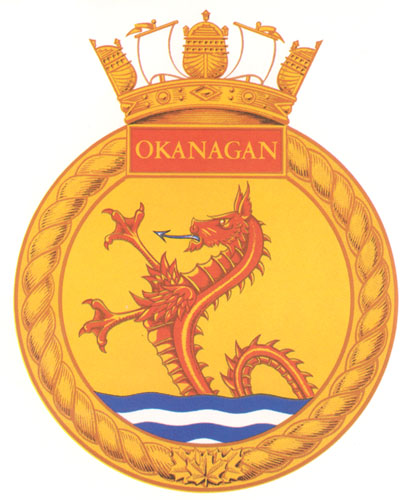Naval Ships with Okanagan Names
The Canadian Navy has a long tradition of naming ships after Canadian towns, cities and geographical features such as rivers.
While there are no current naval vessels with Okanagan Valley-related names in commission, there were two ships named after Okanagan Valley place names during WW II.
Pacific Threats
The allied maritime supply lines to the Aleutians and Alaska were especially important from the initiation of the war in the Pacific with the Japanese attack on Pearl Harbour in December, 1941. The threat posed by Japanese Imperial Forces in 1942-43 was especially great with the occupation of two Aleutian Islands, Attu and Kiska by Japanese forces. In addition, Japanese aircraft carriers and submarines presented the constant potential of attack on sea lanes and BC itself.
The main Japanese threat to BC was removed by the victories of the United States Navy in major battles in the far-flung Pacific Campaign however a submarine threat remained throughout the war and HMCS Kelowna and the other ships of the RCN maintained their patrols against this danger throughout the war.

HMCS Kalamalka
HMCS Kalamalka, a Llewellyn class minesweeper, was built in the Vancouver shipyard of Benson Ltd and commissioned in the Royal Canadian Navy (RCN) on 2 October 1944. The ship served in a coastal defence role on the west coast until paid off at the end of the war on 16 November, 1945.
Type
Minesweeper
Class
Llewellyn
Displacement
228 tonnes
Length
119.3 Feet
Armament
4 x. 50 cal machine guns
Top Speed
12 Knots
Pennant Number
J395
Crew
23 (3 0fficers)
HMCS Kelowna
The HMCS Kelowna was a Bangor class minesweeper in the RCN during WWII. The ship was built and commissioned as part of the RCN’s Pacific fleet and patrolled the BC coastline protecting Canada’s west coast maritime frontier.
Type
Minesweeper
Class
Bangor
Displacement
672 tonnes
Length
180 Feet
Armament
1-4″ Gun, 1-3″ Gun, 2-20mm
Top Speed
16 Knots
Pennant Number
J261
Crew
83 (6 Officers)
Submarines
In the post-war era the Canadian Navy went through a series of changes as Canada’s maritime defence policies adapted to the changing realities of the Cold War and Canada’s role in NATO, the North Atlantic Treaty Organization.
The Canadian Navy had built the third largest navy in the world by the end of WW II and although the navy was drastically reduced in peacetime the tremendous expertise in anti-submarine warfare (ASW) developed during the war continued to serve the Canadian Navy well. Within NATO navies Canada specialized in this field of maritime warfare with the Canadian Navy pioneering major developments such as the incorporation of ASW helicopters on ASW specialized destroyer escorts with advanced sonar sensors.
Submarines had historically played an important role in training Canadian ASW forces during WW II and the immediate post-war era using Royal Navy and ex-United States Navy submarines for this role. Submarines have a critical role in developing the combat readiness skills of the surface fleet in countering potential submarine threats. This important function was continued with the acquisition of three British subs in the 1960s. The post-war O class submarines took their class name from the first letters of their names. In the Royal Navy, the lead boat was Oberon. (Customarily, submarines are called “boats,” not “ships,” no matter what their size.) The Canadian boats were named after First Nations tribes.
HMCS Okanagan
Built at the Chatham Dockyard in England, the Okanagan was named after a tribe of the Interior BC Salish Nation. Commissioned into the Canadian Navy on 22 June 1968 the boat served in the Atlantic fleet based in Halifax until 14 September 1998. A special paying off ceremony (the term for bringing a ship’s naval service to an end) including a celebration of 30 years of service in the navy was held soon after on the 28th September that year.
Type
Submarine
Class
Oberon
Displacement
1,610 / 2,410 tons surfaced / submerged
Length
295 x 29 x 18 feet
Armament
Mk.37 Mod 2 electric homing torpedoes 6x 21″ tubes forward, 2x 21″ “short” tubes – stern firing- with Mk.37 Mod 0 electric straight running torpedoes.
Top Speed
2 x 3,680 hp V16 diesels, 2 x 3,000 hp electric motors, diesel-electric, 2 shafts, 6000 shp, 12/16 knots
Pennant Number
74
Crew
68
“For two decades now, our collection has wowed both locals and visitors, and we’re excited for that to continue. This is part of our shared history and a chance for us to come together in remembrance."
- Keith Boehmer, Military Historian
Make History
Or at least help preserve it. Join the Kelowna Museums Society and keep history alive through exhibitions, programming, collections, conservation, and research. Our vision is to inspire a community to be alive with its history – connecting people and place.



